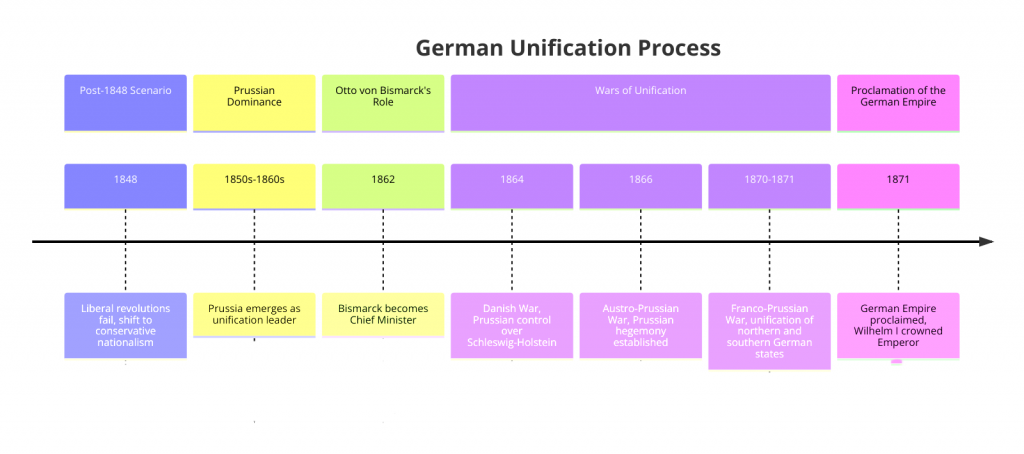The process of German unification was a complex and strategic endeavour predominantly led by the Kingdom of Prussia in the late 19th century. Following the failed liberal revolutions of 1848, which aimed to unify the German states under a democratic regime, the movement for unification took a conservative turn under the leadership of Prussia.

Initial Steps-
- Post-1848 Scenario- After the suppression of the 1848 revolutions, nationalism in Germany shifted from its liberal and democratic roots to a more conservative approach, emphasising state power and political domination.
- Prussian Dominance- Prussia, with its powerful military and bureaucracy, emerged as the leader of the unification movement. The liberal attempt to unify Germany was crushed, paving the way for a conservative-led unification process.
Otto von Bismarck’s Role-
- Strategic Leadership- Otto von Bismarck, the Prussian Chief Minister, became the chief architect of unification. He utilised diplomacy, political acumen, and the Prussian military to achieve his goals.
- Realpolitik- Bismarck’s policy of Realpolitik, or realistic politics based on practical rather than moral or ideological considerations, was crucial in navigating the complex landscape of German and European politics.
Also Check – Otto von Bismarck- Architect of German Unification
Wars of Unification-
- The unification process was marked by three decisive wars, orchestrated by Bismarck to consolidate Prussian dominance and unify the German states-
- Danish War (1864)– Led to Prussian control over the duchies of Schleswig and Holstein.
- Austro-Prussian War (1866)– Established Prussian hegemony over the German states, excluding Austria from German affairs and leading to the formation of the North German Confederation under Prussian leadership.
- Franco-Prussian War (1870-1871)- Unified the northern and southern German states against a common enemy, culminating in the capture of Paris and the decisive defeat of France.
Proclamation of the German Empire-
- Versailles Ceremony (1871)- The German Empire was officially proclaimed on January 18, 1871, in the Hall of Mirrors at the Palace of Versailles, with Prussian King Wilhelm I crowned as the first German Emperor. This act symbolised the culmination of the unification process and the establishment of Germany as a major European power.
The unification of Germany under Prussian leadership was a calculated process that combined diplomatic strategy, military might, and political pragmatism. It transformed the fragmented German states into a powerful nation-state, significantly altering the political landscape of Europe.
Also Check – The Role of Women in Nationalist Struggles – Short note
Also Check – The Frankfurt Parliament
Also Check – The Balkans – Nationalism, Imperialism, and World War I
Also Check – The Rise of Nationalism in Europe- 39 Mcqs
Also Check – The Rise of Nationalism in Europe – Class 10 – Notes
Also Check – Giuseppe Mazzini – Italian Revolutionary thinker
Also Check – Giuseppe Garibaldi- Italian freedom fighter
Also Check – Count Camillo de Cavour
Also Check – Otto von Bismarck- Architect of German Unification
Also Check – Briefly trace the process of German unification
Also Check – Napoleon and the Napoleonic Code- Impact on European Societies and Legal Systems
